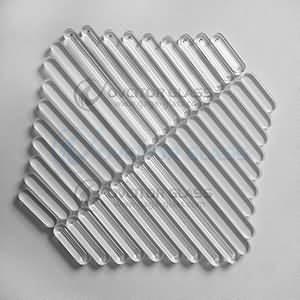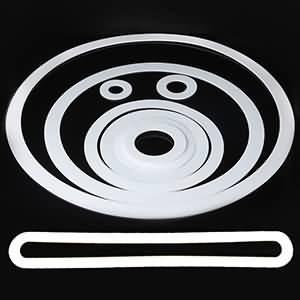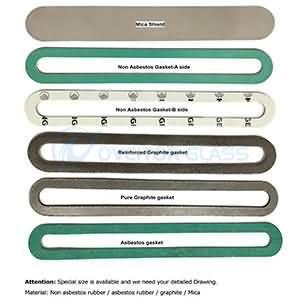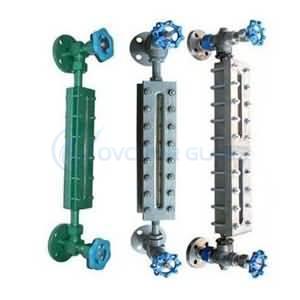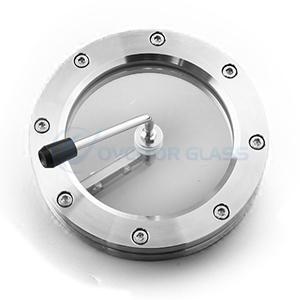The Method of Glass Tempering
1 Chemical tempering method
The tempering method that changes the glass surface composition through chemical methods and increases the surface lamination stress to increase the mechanical strength and thermal stability of the glass is called chemical tempering. Because it strengthens glass through ion exchange, it is also called ion exchange enhancement method. According to the type of ion exchange and the temperature of ion exchange, it can be divided into ion exchange method below the transition point (referred to as low temperature method) and ion exchange method above the transition point temperature (referred to as high temperature method). The principle of the chemical enhancement method is to change the surface composition of the glass according to the mechanism of ion diffusion. The glass is immersed in a high-temperature molten salt at a certain temperature. The alkali metal ions in the glass and the alkali metal ions in the molten salt are caused by diffusion. Mutual exchange occurs, resulting in "crowding" phenomenon, causing compressive stress on the glass surface, thereby increasing the strength of the glass.
According to the theory of glass network structure, glassy matter is composed of a disordered three-dimensional spatial network. This network is composed of oxygen-containing ion polyhedrons, the center of which is occupied by s Al or P ions. These ions form a network together with oxygen ions, and the network is filled with alkali metal ions (Na, K) and alkaline earth metal ions. Among them, alkali metal ions are more active and easy to precipitate from the inside of the glass. The chemical tempering method is based on the natural diffusion and mutual diffusion of ions to change the composition of the glass surface layer, thereby forming a surface compressive stress layer. However, the surface compressive stress layer produced by the ion exchange method is relatively thin and very sensitive to surface micro-defects. A small surface scratch is enough to reduce the strength of the glass.
Advantages and disadvantages: The strength of chemically strengthened glass is close to that of physically strengthened glass. It has good thermal stability, low processing temperature, and the product is not easily deformed, and its products are not restricted by thickness and geometry. The equipment is simple to use and the product is easy to realize. However, compared with physical tempered glass, chemical tempered glass has a long production cycle (exchange time up to tens of hours), low efficiency and high production cost (molten salt cannot be recycled, and high purity requirements). The fragments are similar to ordinary glass and are safe. It has poor performance and unstable performance (bad chemical stability), physical properties such as mechanical strength and impact resistance are easy to fade (also called relaxation), and the strength decays quickly at any time.
Application: Chemically tempered glass is widely used in flat glass of different thicknesses, thin-walled glass and shaped glass products for bottles and cans, as well as fireproof glass.
The principle of physical toughening is to heat the glass to a suitable temperature and then cool it quickly, causing the glass surface to shrink sharply, resulting in compressive stress, while the middle layer of the glass cools slowly, and it is too late to shrink, so tensile stress is formed, which makes the glass obtain higher strength. Generally speaking, the higher the cooling strength, the greater the strength of the glass. There are many physical tempering methods, which are classified according to the cooling medium, which can be divided into: gas medium tempering method, liquid medium tempering method, particle tempering method, atomizing tempering method, etc.
Gas medium tempering method, namely air-cooled tempering method. Including horizontal air cushion tempering, horizontal roller tempering, vertical tempering and other methods. The so-called air-cooled tempering method is a production method in which the glass is heated to close to the softening temperature of the glass (650~700Deg.C), and then air is blown on both sides of the glass to rapidly cool it to increase the mechanical strength and thermal stability of the glass. . The quenching of heated glass is an important link in the production of tempered glass by the physical tempering method. The basic requirement for glass quenching is rapid and uniform cooling to obtain uniformly distributed stress. In order to obtain uniform cooling of the glass, cooling must be required The device effectively dissipates heat and wind, facilitates the removal of accidental broken glass, and should minimize its noise.
Advantages and disadvantages: The advantages of air-cooled tempering are lower cost, larger output, higher mechanical strength, heat shock resistance (safe working temperature up to 287.78Deg.C) and higher heat gradient (can withstand 204.44Deg.C), and in addition to enhancing the mechanical strength of the air-cooled tempered glass, it can form small fragments when broken, which can reduce the harm to the human body. However, there are certain requirements for the thickness and shape of the glass (the minimum thickness of glass tempered by domestic equipment is generally about 3 mm), and the cooling rate is slow, and the energy consumption is high. For thin glass, there is still glass deformation during the tempering process. The problem is that it cannot be applied in areas that require high optical quality.
Application: At present, air tempering technology is widely used, and air tempered glass is mostly used in automobiles, ships, and buildings.
2.2 Liquid medium tempering method Liquid medium tempering method, namely liquid cooling method.
The so-called liquid cooling method is to heat the glass to close to its softening point and then place it in a quench tank full of liquid for tempering. At this time, brine can be used as the cooling medium, such as mixed brine of potassium nitrate, potassium nitrite, sodium nitrate, and sodium nitrite. In addition, mineral oil can also be used as the cooling medium. Of course, additives such as toluene or carbon tetrachloride can also be added to the mineral oil. Some special quenching oil and silicone oil can also be used. During liquid tempering, because the edge of the glass plate enters the quench tank first, bursting caused by uneven stress will occur. In order to solve this problem, air cooling or liquid spraying can be used for pre-cooling, and then put into organic liquid for rapid cooling. You can also put water and organic solution in the quench tank. The organic solution floats on the water. When the heated glass is put into the tank, the organic solution plays a role of pre-cooling, absorbing part of the heat, and then entering the water for rapid cooling. The immersion cooling liquid is used, and the liquid spray method can also be used, but the immersion method is generally used. The British Triplex company used the liquid medium method to temper glass with a thickness of 0.75 to 1.5 mm as early as the 1980s, ending the history of physical tempering that cannot temper thin glass. The difficulty of the liquid tempering method is to establish a reasonable liquid-cooling process system. Two problems should be paid attention to during liquid-cooling tempering: one is the excessively high compressive stress layer, and the other is to avoid glass bursting.
Advantages and disadvantages: The liquid medium tempering method is adopted. Because the specific heat of water is large and the heat of vaporization is high, the amount is greatly reduced, thereby reducing energy consumption and cost, and the cooling speed is fast, the safety performance is high, and the change is smaller in shape. Since the glass is heated and inserted into the liquid medium during cooling, it is easy to be unevenly heated for glass plates with a large area, which will affect the quality and yield.Application: Mainly suitable for tempering various thin glass with a small area, such as glasses glass. LCD glass, glass for optical instruments, etc.
2.3 Particle tempering method
This method is a process in which the glass is heated to close to the softening temperature and then quenched in a fluidized bed with solid particles generally smaller than 200 m of alumina particles to strengthen the glass. In theory, using solid as a cooling medium can produce thinner, lighter, and stronger toughened glass. Therefore, from the mid-1970s to the early 1980s, Britain, Japan, Belgium, Germany, etc. successively applied this technology For production.Advantages and disadvantages: Particle toughening method can toughen ultra-thin glass. High strength and good quality. It is currently an advanced technology for manufacturing high-performance tempered glass. Compared with the traditional wind tempering process, the new particle tempering process. The cooling energy of the cooling medium is large, suitable for tempering ultra-thin glass, and the energy saving effect is significant (energy saving 40%). However, the cost of the cooling medium for the particulate tempering process is relatively high.
Application: high-strength, high-precision thin glass and ultra-thin glass.
2.4 Fog tempering method
Using atomized water as the cooling medium, and using spray exhaust equipment, the glass can be cooled more evenly during the tempering process, with lower energy consumption and better performance after tempering. The spray exhaust equipment is composed of several grid-shaped barrel-shaped structures connected side by side and arranged on the bottom plate. Each barrel-shaped structure is composed of a bottom plate, a partition, a nozzle, and a number of exhaust holes. Similar to the gas method, but the cooling medium used is not air, but atomized water. The feature is that the atomized water is used as the cooling medium to temper the glass. The specific heat of water is larger, and the heat of vaporization of water in all liquids is also the highest. During the glass tempering process, water mist is continuously sprayed onto the heated glass surface, and the atomized water in the form of particles quickly absorbs heat and becomes water at 100°C, and then vaporizes, using the high specific heat of water and the heat of vaporization High this characteristic. Take away (absorb) a large amount of heat from the surface of the glass instantaneously, so that the glass is tempered and tempered, causing a sexual compressive stress on the surface of the glass, thereby improving the tensile strength of the glass and tempering the glass. Water mist (atomized water) can be sprayed on the heated glass surface by compressed air blowing, steam blowing or hydraulic spraying. As the atomized water contacts the red hot glass, it will quickly absorb heat and vaporize and expand , If it is allowed to diffuse freely, it will affect the uniform cooling of the glass and easily cause the glass to burst. to this end. It is necessary to design a unique spray exhaust equipment so that the vaporized and expanded water can be pumped away on the spot. It will not spread along the glass surface.Advantages and disadvantages: The cooling medium is easy to obtain, the cost is low, and it does not pollute the environment. It can also temper thin glass that cannot be tempered by general gas, liquid and particulate tempering. But cooling uniformity is more difficult to control.
Application: Because its cooling system is difficult to control, there are currently fewer applications.
To sum up, chemical tempering is suitable for tempering thin glass, glass with high precision or complicated shape. Most of its products are used for special purposes such as glasses, aviation glass, and electronic substrate glass. However, the life of chemically tempered products is relatively short, generally less than 3 years, while the life of physical tempered products is more than 30 years; the fine-grained tempered glass process can produce high-quality thin tempered glass with high strength and no stress marks, but it will affect the surface quality of the glass; The liquid tempered glass process is suitable for tempering small-sized thin glass and ultra-thin glass.
In addition, acid corrosion also affects the strength of glass. The principle of acid corrosion is to remove or passivate the cracks on the surface of the glass through acid corrosion, reduce stress concentration, and restore the inherent high-strength characteristics of glass. It is also possible to organically combine the above-mentioned glass reinforcement technologies to give full play to their respective strengths and fully increase the strength of the glass to form the so-called comprehensive reinforcement technology.
